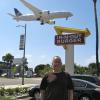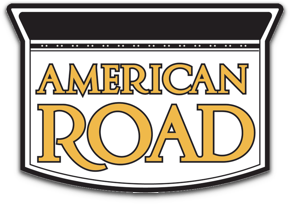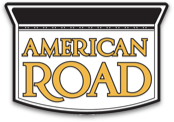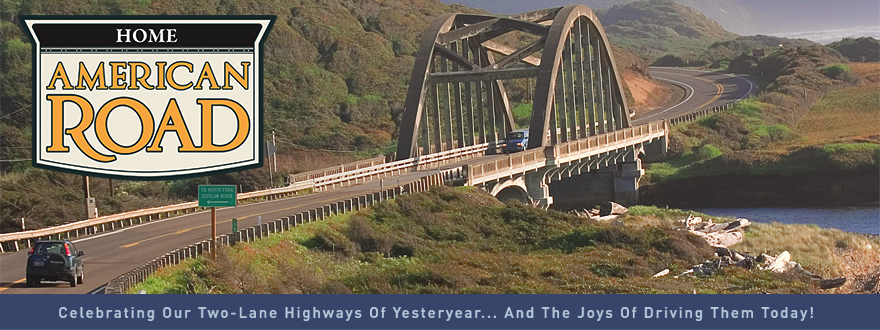-
Posts
328 -
Joined
-
Last visited
-
Days Won
4
Content Type
Profiles
Forums
Gallery
Blogs
Calendar
Everything posted by mga707
-

I-10 Exit Reconstruction At Old Us 80 Interchange
mga707 replied to mga707's topic in Old Spanish Trail / U.S. 80 / U.S. 90
What is even 'neater' about this particular old 80 section--which I had not discovered until I read Jeff Jenson's excellent "Broadway of America" guidebook last year--is that there are several locations along this loop where the original 1921 roadbed is still visible, along with old bridge abutments, etc. The alignment was slightly changed in several places circa 1933, which is probably when the first blacktop was laid down. In one small area there are four distinct road eras: The original 1921 dirt Bankhead Highway/Broadway of America/Old Spanish Trail, the 1933 improvement/slight realignment, the 1955-56 major realignment over Davidson Canyon, eliminating this section as part of US 80, and the early 1960's overlay of Interstate 10 over the 1955/56 alignment, with two new lanes of blacktop, and a twin bridge over the canyon, paralleling the 1955/56 roadway. Now the interchange rebuild/realignment will add a fifth era to part of this section. Lots of highway history here. Actually, I've been to the excellent Museum of Flight at Boeing Field, Seattle, although it has been a good 20 years. Next summer I'll hit all of the Portland-area aviation history establishments, which will all be new to me. Will get back to BFI for another jaunt through the Museum of Flight (love the original Boeing "Red Barn"!) someday! -

I-10 Exit Reconstruction At Old Us 80 Interchange
mga707 replied to mga707's topic in Old Spanish Trail / U.S. 80 / U.S. 90
I know what you mean. One could always tell that this particular exit had some years on it just by the way it was designed. 1955 state-of-the-art doesn't take long to become 2010 totally obsolete! -
The Arizona Department of Transportation (ADOT) is currently in the midst of a major I-10 exit realignment/reconstruction at Exit 289 east of Tucson. This exit, signed as Marsh Station Road, is significant to 'roadies' as it is the east end of of an old US 80 loop off of the current alignment. This loop extends eight miles west to Exit 281, the SR83/Sonoita exit, and is well-known as a prime example of 1930's-era US highway construction. The loop was bypassed circa 1955-56 by a newer, straighter US 80 section over Davidson Canyon that was incorporated into Interstate 10 by the early 1960s. The reconstruction of the Marsh Station Road exit is extensive, with the entire exit being moved eastward about a mile and a half. Once the new exit is completed, in a couple of years, the old exit, including a part of the original 1920s Old Spanish Trail/US 80 alignment, will be removed and the Interstate alignment widened where the old exit underpass once stood. As it is now, this is the only section of I-10 outside of the Tucson and Phoenix metro areas where the speed limit is reduced to 65mph due to the narrowness of the median. Once the new exit is opened and the Interstate realigned, it will be 75 all the way. So, if one wants to drive the full extent of the old 80 loop, do it soon!
-
Ah, a Studie! When looking through my reference book, I missed it mainly 'cause I wasn't looking much before 1940. Should've known that Studie was a style leader in moving the headlights into the fenders just as they were the first to bring out an all-new postwar car that made the 'big three's' 1946-47 offerings look positively ancient! Thanks!
-
Thanks for the guess, but my old auto source ("Encyclopedia of American Cars 1930-1980") shows all Pontiac model years as having 'normal' round headlights, both before and after they migrated from the sides of the grille into the fenders. The '39 Nashes had a somewhat similar odd headlight shape, but not quite the same. Also a different grille pattern. Any other guesses?
-
Dave: The "old time AC" pictured is really an auto version of that ubiquitous Arizona rooftop fixture, the swamp-box cooler. The "swamp-box" is an ingeniously simple device in which a rotating fan motor sucks warm air over water-laden pads (aspen chips make the best cooler pad material), cooling the air before it is drawn in through an opening in one side of the cooler and blown throughout the house via the ductwork. A cooler is actually more efficient than an air conditioner (and a heck of a lot cheaper to run) during the first part of a southern Arizona summer, from early May through the end of June, when 100+ degree days with single-digit humidity (I've experienced 2%!) are the norm. They definitely lose their edge over AC once the 'monsoon season' with higher humidity (20-40%) kicks in around the first of July through mid-September. Now that it is once again drier and not as hot, a cooler again works wonderfully from mid-September through October, as summer winds down. The ideal set-up, of course, is to have both installed at one's home. The 'car cooler' is even simpler, as the blower motor is not needed since the forward motion of the auto forces the air through the water-infused pad in the device. I do remember such devices as being fairly common out here (Tucson) even back in the '60s when auto AC was not nearly the standard equipment that is is today. My family did not have them, but we did splurge on huge, dealer-installed under-dash AC units (remember those?) on two of the first three cars that I clearly remember: A 1960 Dodge Dart Pioneer and a 1961 Rambler American. The third vehicle from my dimly-remembered youth, a much-used 1952 Ford, had "roll down the windows and sweat" cooling only! As far as the WAAAM is concerned, I am looking forward to visiting it next summer, when the World Airline Historical Society hold it's annual convention and trade show in Portland, adjacent to PDX. One of the "Rose City"s enticements is the fact that there are FIVE aviation museums within an hour or two drive of Portland. The best-known is probably the Evergreen Air Museum in nearby McMinnville, and the WAAAM is one of the others. Could you (on anyone) ID the car that proudly wears the 'car cooler'. I should know it with that distinctive headlight treatment, but I just can't ID it!
-
Wow, small world ("but I'd hate to have to paint it."--Stephen Wright)! I actually know somebody whose father was born and raised in Loogootee! He returned from WWII with his French war bride and one can imagine the culture shock she experienced, going from Paris to Loogootee, Indiana! Shortly thereafter they moved to 'big city' Indianapolis (Speedway, actually), so that probably was not quite as much of a shock for his bride!
-
According to my car reference book, two-door hardtops were quite popular in that year's Buick lineup, as they were for all makes at that time. All three nameplates--LeSabre, Invicta, and Electra, offered them. The rare two door model was the pillared coupe (two-door sedan), which was only offered as a bottom-end LeSabre and did not rack up many sales. Two-door sedans, with their 'cheap' aura, were on their way out with nearly all makes at that time, at least in their full-sized offerings.
-
Looks like it really is a section of a 1960 Buick Invicta or LeSabre (three "portholes"). If not, it's a really well-done replica!
-

Skyline Drive, Blue Ridge Parkway, Etc.
mga707 replied to DennyG's topic in State Highways & Other Roads
If I ever do the Natchez Trace/Blue Ridge Parkway road trip, I'd probably want to spend a little time on I40 around either Nashville or Knoxville just to satisfy my Steak'N'Shake craving. Chili Mac Supreme--mmmm! -

Skyline Drive, Blue Ridge Parkway, Etc.
mga707 replied to DennyG's topic in State Highways & Other Roads
One of my fantasy road trips that I would love to do someday is do combine the Skyline Drive/Blue Ridge Parkway with the Natchez Trace Parkway and drive the entire length of both. It's not that far from the end of the NT Parkway west of Nashville to the SW end of the BR Parkway at the southeast entrance of Great Smoky Mtns. Nat'l. Park. Has anyone on here ever done this? I'll bet it would be a fun trip. -
Anyone else catch the photo caption error? "Marquis" in place of "marquee". Spell-check has it's limits!
-
Wow! Just when i was thinking "...been too quiet on here lately...", along comes Dave Darby with all of this GREAT stuff!! Thanks, Dave!
-

New Broadway Of America Book
mga707 replied to drivetheost's topic in Old Spanish Trail / U.S. 80 / U.S. 90
Just a quick note to alert anyone interested that the new BOA book is now out. I purchased mine today. Quite interesting, with loads of great pictures, many that have never before been published. -

Grand Coulee Dam Overflowing!
mga707 replied to Keep the Show on the Road!'s topic in State Highways & Other Roads
Agree totally, all I can add is "Dam!" The "then and now" is simply awesome--I guess, according to the current lack of a posted prohibition, one CAN stop now! -
I assume everyone on here has seen, or at least heard about, "Horatio's Drive"? It's a recounting of the very first transcontinental auto trip, before there were really ANY auto roads to speak of outside of major cities. IIRC it was first broadcast on PBS in 2003 to mark the 100th anniversary of said drive in 1903. I have it on DVD--very interesting!
-

New Broadway Of America Book
mga707 replied to drivetheost's topic in Old Spanish Trail / U.S. 80 / U.S. 90
Thanks for the info! I'm definitely going to order this book. -
I think this card is more likely a late '30s shot. None of the autos in it have headlights that have 'migrated' from the sides of the hood to the fenders, which occurred in most car lines in the 1937-39 timeframe.
-

Cedar Key, Gulf Coast, Florida
mga707 replied to Keep the Show on the Road!'s topic in State Highways & Other Roads
My first time through Sedona was in 1968 at age 10--most recent time just this past January. One constant on both visits was a stop for food at the Coffee Pot Cafe. It's one of the few things that was there in the '60s before Sedona was 'discovered' that is still in business today, and still cranking out the famous omelets! The Glenwood/Pleasanton area of New Mexico is truly an undiscovered gem. Both adjoining towns are indeed on a two lane, US 180, about midway between Silver City and Alpine AZ. They are in a beautiful setting, with the primordial and roadless Gila wilderness/Mogollon mountains to the east. One spot that is an absolute 'must-stop' is Catwalk Canyon. An ambitious and ingenious construction project from the late 1800s diverted water from the mountains above to the mining operations below through the canyon via huge cast iron water pipes. At a later date a walkway--the "catwalk"--was placed on top of the pipes and still exists today. One can walk several miles up the canyon, a beautiful riparian area with flowing water and huge old cottonwoods, via the "catwalk". At the top of the canyon, accessible by paved but narrow and winding NM route 159, is the mostly-but-not-quite ghost town of Mogollon. There are also some great hot springs nearby, along the San Francisco River, but in the interest of keeping them from being trashed and ruined I won't give specific directions! Anyway, the area is wonderful, and as yet almost totally unknown by anyone outside the area, although it is a popular getaway for Silver City-area folks. ...and so we go from the peaceful shores of the Florida upper Gulf coast to the equally peaceful solitude of the New Mexico wilderness! -

Cedar Key, Gulf Coast, Florida
mga707 replied to Keep the Show on the Road!'s topic in State Highways & Other Roads
I can relate to this! There are two tiny towns (three, actually, as one of the sites is two adjoining communities) out here in the southwest that I've been to and loved that could easily, and unfortunately, become "Sedonafied". I made up that term but I think you all what it implies--see above! I almost hate to mention them, but here they are: Boulder, Utah; and the Glenwood/Pleasanton area in SW New Mexico. Here's hoping they--and Cedar Key--stay undiscovered! -

Cedar Key, Gulf Coast, Florida
mga707 replied to Keep the Show on the Road!'s topic in State Highways & Other Roads
Ah, thanks for IDing the lyric snippet. Now hopefully it will leave my brain! -

Cedar Key, Gulf Coast, Florida
mga707 replied to Keep the Show on the Road!'s topic in State Highways & Other Roads
I'm intrigued by the next coastal town to the southeast as shown on Dave's (KtSotR) map: Yankeetown. Why in the world is there a "Yankeetown" in northern Florida, which, as most know, is far more "southern" in character and history than southern Florida! There's got to be a story behind this community and it's somewhat prejorative (at one time, at least) name. Anyone know? Another musing: Ever since reading this thread, the line "Travis McGee's (MacGee?) still in Cedar Key" keeps rattling around in my brain. I'm assuming it's a song lyric, but I just can't pin it down. What song, and who is or was Travis Mcgee? While I never made it up to Cedar Key--or Yankeetown--I did explore the area along the coast to the south about 20 years ago. Weekie Watchee(sp?), etc. I liked it: Far less developed and touristy than far too much of the rest of Florida has become. Now I want to check out Cedar Key--sounds delightful! -
Bravo! Well done, as always. Saw that this was posted earlier but waited until I had the time to fully enjoy the trip. And so I did! What is it about small towns and interesting, unusual old cars? They're always present. Loved the shot of the 'anvil building' with the end-of-the-line (54?) Kaiser, '61 Chevy Biscayne or Bel Air, '71/'72 Mustang Mach 1, and '64/'65 Barracuda out front. How great it would be to walk out and think "Which classic car should I drive today?" The second car I owned (1978-84) and first one I purchased myself was a '72 Mach 1, so that one really resonates. I want it!
-

Random Rant - Brownsville, Pa Is Haunting Me...
mga707 replied to Steve_Colby's topic in National Road / U.S. 40
What is the cause of Brownsville's decline? Is it a former steel town? It isn't by chance the faded Pennsylvania town where parts of "The Deer Hunter" was filmed, is it?



